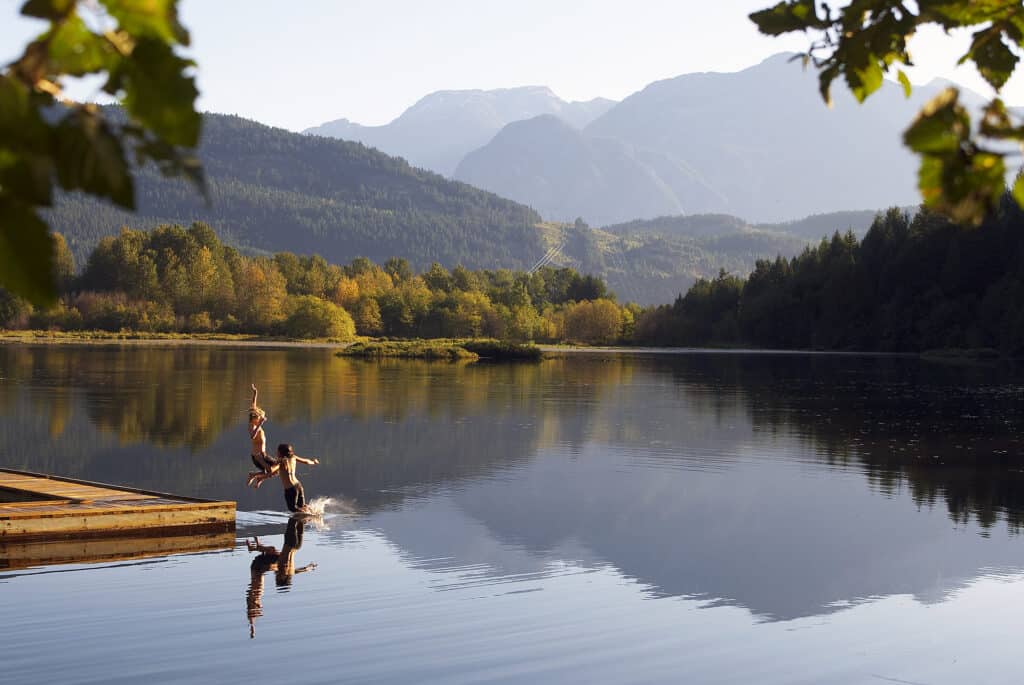Providing parks and greenspace are not only ways to beautify communities and make life more pleasant, but such spaces also play a central role in human health and well-being. Mounting evidence now tells us that trees, parks, and natural elements play an essential role in a healthy human habitat.1
Healthy by Nature is a movement about the physical and mental health benefits of spending time in nature, and its principles suggest that:
- spending time in nature improves human health
- human health depends on healthy ecosystems
- parks and protected areas contribute to vibrant, healthy communities2
Examples of public greenspace include municipal parks, provincial, and national parks, Crown land and ecological reserves, and public facilities (e.g. school grounds, playing fields). Privately owned greenspace also plays a valuable role in communities, and includes working and productive landscapes (agriculture and forests), golf courses, open space holdings in subdivisions, and rail and utility corridors.
What is this issue about?
Supporting healthy choices
People tend to be physically active when it is convenient and affordable. This is why public health supports building community environments that make it easy, attractive, safe, and affordable for residents to be active in their daily lives. Parks and natural areas are part of this focus,3 as well as active transportation networks that help people get to destinations in the community through active movement.
Alleviating health inequities
Parks provide the venues for commonly enjoyed activities – organized sports, running, biking, gardening, hiking, swimming, and many others. Research shows that when the physical health of individuals with similar socio-economic status are compared, those individuals with better access to nature are healthier.4 We also know that convenient access to parks and greenspace particularly benefits people with lower incomes. They typically have poorer health status due to socio-economic factors, and are limited by time and money to go to the gym or participate in recreation programs.
Building awareness
In the last decade, studies about the health impacts of greenspace and parks are becoming more rigorous. New evidence about health and natural environments is informing decisions on policy, investments, and programs.5
Why are parks and greenspace important for health and well-being?
Physical health, healing, and development
Visiting a park, or even seeing nature from a window, bring benefits to physical health, healing, and human development.
- People who live close to parks use them for physical activity. Studies find that people who live within 800 metres of a park get 50% of their vigorous physical activity while at the park. People who live just 800m further away get just 16% of their physical activity while at the park.6
- Physical benefits can also be derived simply from viewing nature. Patients in hospital rooms with a view of nature generally recover more quickly, require less pain medication, and have fewer post-surgical complications than patients in rooms with urban views.7
- Natural spaces help children to build their gross motor skills, interact socially, alleviate adverse effects of exposure to chronic stress,8 and reduce rates of obesity and cardiovascular disease.
Mental health
Being in nature improves mental health and decreases anxiety and stress.
- Access to natural environments can improve cognitive functioning, impulse control, resilience to stressful life events, and overall mental health. Conversely, lack of access to natural environments increases deficit/hyperactivity disorder (ADHD), clinical depression, stress, and anxiety.9
- Children with ADHD particularly benefit from access to greenery: a 20-minute walk in an urban park benefited the concentration performance of children with ADHD at least as much as prescribed ADHD medications.10
Social function
Parks and green spaces are places to connect with other people in the community, and improve social well-being.
- Studies show that people who connect with nature feel less isolated and less focused on themselves. They form connections with neighbors, and aggression and crime decrease.11
- Community gardens are shown not only to facilitate access to healthy food, but also to improve mental health by reducing stress and building networks that span generations and cultures.12
- Common spaces in social housing projects are used more when they have trees and grass, and the people living adjacent to green spaces know more of their neighbours, report a stronger feeling of belonging, and are more supportive of each other.13
Ecosystem health
Parks and green spaces can provide a habitat for wildlife, as well as support ecosystem functions such as air and water purification, and flood protection.
- Green spaces can support and preserve ecological functions, including healthy air and water.
- By absorbing rain and snow, green infrastructure recharges aquifers and releases stored water into watercourses. Green infrastructure filters pollutants and sediments out of surface water, buffers developed areas from flooding, and prevents soil erosion.14
Why do parks and greenspace matter for local governments?
Most people agree that parks and greenspace contribute to sustainability, identity, and the spirit of a place. However, parks and greenspace also have economic value. Parks measurably improve the property values of nearby homes, boost tourism,15 and play a key role in attracting residents – particularly workers that build a diverse local economy.16 In addition, parks and greenspace deliver environmental health value as carbon sinks, biodiversity, and habitat.17 Moreover, managing rainwater infiltration and stormwater with green infrastructure (e.g. swales, permeable landscapes) can be more effective and less costly than traditional hard infrastructure (e.g. pipes in the ground).18




